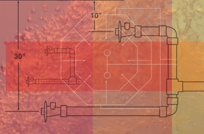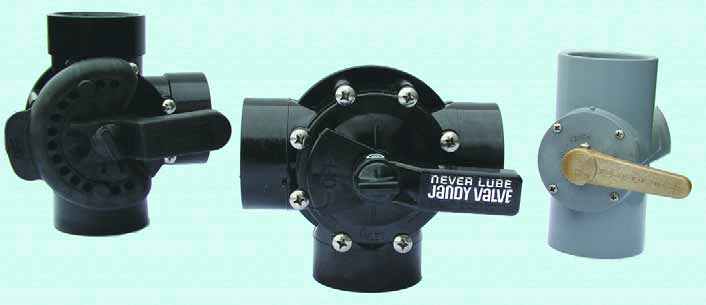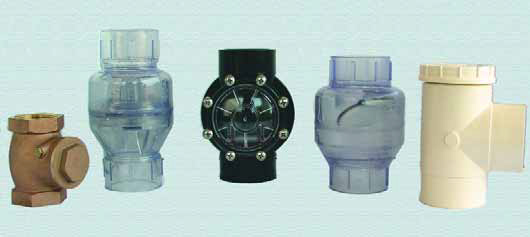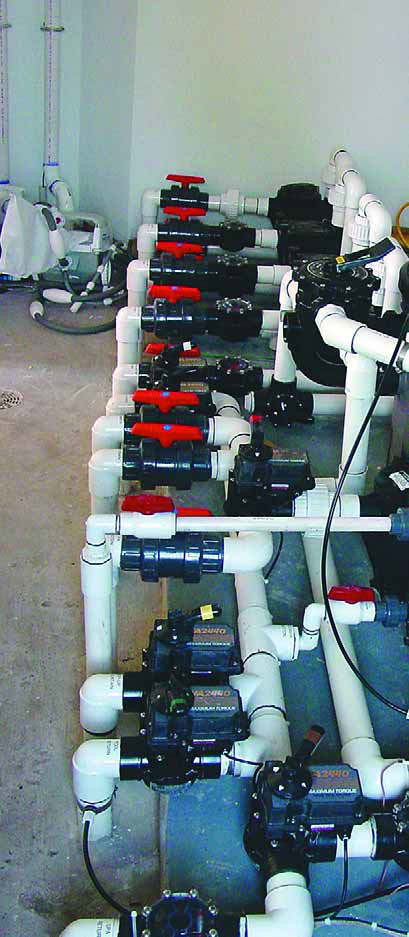Valve Values

Watershape construction is far more sophisticated now than at any time in history.
Swimming pools, for instance, are commonly designed to include spas with complex jet manifolds and a wide variety of controllable effects, while vanishing edges, perimeter-overflow details, multiple water levels and various water-in-transit designs are also increasing in popularity.
Fountains and waterfalls and the full range of other waterfeatures also are more elaborate, and what all of them require are well-planned systems of valves to control and divert water to all the necessary components, effects and details. These are situations in which valve choice is, in fact, critical to hydraulic-system design.
The many types of valves can be separated into three specific categories roughly according to application. There are some that divert water, others that isolate water and still others that prevent flow reversal – and there are several choices within each category with a variety of potential plumbing connections (sockets, threads, unions, flanges and more), again depending upon the specifics of the application.
DIVERSION TACTIC
Let’s begin our closer examination of this range of possibilities with the most basic, common valve type – that is, those used to divert water from one plumbing run to another, as from a pool to a spa or from a pool to a waterfeature of some type.
Diverter valves are typically made with three ports and have a valve body that looks like a “T.” One port serves as the inlet (usually the branch side of the tee); the other two are possible return paths for the water as it heads back, for example, to a pool or spa. The active part of the diverter rotates on an axis in the central portion of the valve body and can swing up to 180 degrees, thereby allowing the user to send or pull water to both downstream ports or isolate one port at a time.
 This valve type is extremely popular because it effectively replaces multiple isolation valves and makes plumbing schemes much simpler for the contractor. This type of valve also can be automated: Most of these valves have a spleen shaft that will accept most motorizing systems, which opens them to use in automating pool/spa combinations, water effects and in-floor cleaning systems. In addition, these valves serve to divert suction-side flows to cleaners, main drains and skimmers (Figure 1).
This valve type is extremely popular because it effectively replaces multiple isolation valves and makes plumbing schemes much simpler for the contractor. This type of valve also can be automated: Most of these valves have a spleen shaft that will accept most motorizing systems, which opens them to use in automating pool/spa combinations, water effects and in-floor cleaning systems. In addition, these valves serve to divert suction-side flows to cleaners, main drains and skimmers (Figure 1).
IN ISOLATION
A second common type of flow control is performed by isolation valves, which commonly are used in systems where equipment sets are placed below the water line. These valves allow the flow of water to be shut down at key spots along the line and, as the name implies, isolate a component and prevent water from flowing back to it (Figure 2).
 This is a practical necessity in servicing a subgrade pump, filter or heater: Otherwise, the vessel would empty to the level of the pump every time a component was pulled off the line.
This is a practical necessity in servicing a subgrade pump, filter or heater: Otherwise, the vessel would empty to the level of the pump every time a component was pulled off the line.
The second common use for this valve is in adjusting or throttling water flow. In fountain-style waterfeatures, for instance, many times the flow will need to be adjusted and throttled up or down to optimize system performance. In this sort of application, choices are critical and the system designer or installer needs to select among four distinct possibilities:
[ ] Ball valves: Ball valves offer simple operation – basically a quarter turn that starts or cuts off the flow. Typically made of CPVC or PVC (and a range of other materials), they all feature a ball with a hole through its center inside the valve body. When the hole is aligned with the flow, water moves freely from the inlet port to the outlet port. When the ball is rotated 90 degrees, the flow is cut off by the ball’s solid wall. Partial flows result when the ball isn’t turned fully one way or the other.
This type of valve is used frequently to throttle flow or isolate flow to a specific portion of a plumbing network. In the open position, the flow is straight through with minimal pressure drop as long as the porting through the ball is the same size as the inside diameter of the pipe – which makes it helpful that these valves are available in just about any size. Because of the design of internal portion of a ball valve, however, they aren’t particularly well suited to systems that require true fine tuning, such as laminar-flow jets.
[ ] Butterfly valves: The butterfly gets its name from the wing-like action of the flow-controlling disc inside the valve body. This disc operates at a right angle to the flow of the water as it travels through the valve and generally has about the same diameter as the connecting pipe, so it results in limited pressure drop.
| As watershaping projects have gotten more and more complex, the more important it has become for designers and contractors to be aware of the full range of valves available to them – and to recognize, in an equipment room such as this one, that just about every valve type will legitimately come into play. |
These valves, which also come in a wide range of sizes and materials of construction (typically PVC and CPVC), can be used either as on/off isolation valves or as flow-adjusting/modulating devices. Generally, they are used in manual applications, but many can be automated. In addition, some manufacturers offer “swimming pool grade” valve designed for the range of flow rates, pipe sizes and water chemistries found in pools and spas.
The most common application for these devices is in isolating equipment on larger-sized plumbing – generally three-inch diameters and above. They can also be used for flow adjustment but, like ball valves, aren’t particularly suited where fine flow tuning is required.
[ ] Gate valves: The gate valve is the most common member of the isolation-valve family. These devices are used in many of the same applications as ball valves and have the advantage of wide and easy availability from a variety of wholesale and retail sources, with the most obvious drawback being a somewhat higher cost.
As is the case with ball and butterfly valves, when gate valves are fully open, they allow the straight, undisturbed passage of water through an opening that is the same size as the inside diameter of the connecting pipe, so pressure drop is virtually eliminated.
Made of materials ranging from brass to PVC or CPVC, the valve operates when the handle or hand-wheel and stem screw move a cylindrical plug (the gate) up and down at a right angle to the water flow. Gate valves are primarily used for on/off isolation service and do not work as well at throttling flow as do ball or butterfly valves.
[ ] Globe valves: Of the isolation valves discussed here, the globe valve is the least used and understood basically because of the complex of things that happen inside the valve body. As the water flows through one of these devices, it follows a path with two near-90-degree changes in direction and operates when the handle or hand-wheel and stem move a plunger that aligns parallel to the water flow.
These valves are available in a wide range of materials from brass and polypropylene to PVC and CPVC and can be used to isolate components or throttle flow to any degree required, making them an excellent choice for fine flow adjustments. But the internal configuration entails a large pressure drop across the valve, so globe valves aren’t suited to applications in which pressure loss is an issue. In addition, these valves cannot currently be automated.
HOLDING FAST
The third main class of valves – check valves – is used with watershapes mainly to prevent the undesirable reversal of flow in a line. Take the suction side of a pump, for example, where the pump is raised in relation to the body of water or where there are multiple elevations of water (as with a raised spa) and you don’t want water to flow away from the pump and cause a loss of prime when the system is off: In these cases, a check valve is all that is needed. The same principle applies with an air blower line, where a check valve will keep the water from flowing back into the blower.
Check valves are simple devices. When open and under flow, the checking mechanism moves freely and there will be little resistance and minimal pressure drop. When the flow of water stops, however, the checking mechanism closes and the water is held in the pipe.
 Check valves differ in design and are available in the usual wide range of materials, but the most common variety for watershape applications is the swing type, which uses a swinging disc or gate that closes with a minimal amount of back pressure. Many of these valves have an additional lever or spring to promote faster and more secure seating. They also come with different internal configurations, but their functional role is always the same (Figure 3).
Check valves differ in design and are available in the usual wide range of materials, but the most common variety for watershape applications is the swing type, which uses a swinging disc or gate that closes with a minimal amount of back pressure. Many of these valves have an additional lever or spring to promote faster and more secure seating. They also come with different internal configurations, but their functional role is always the same (Figure 3).
A LITTLE BIT SAVVY
As with all aspects of hydraulics, the watershaper needs a good, basic understanding of the three different valve types and their applications and should carefully consider options when laying out systems.
As I mentioned at the start of this article, there’s often a best choice for an application that is overlooked because the designer or installer is stuck in something of a rut and will use one type of isolation valve, say, to the exclusion of all others – even when a simple change in gears would mean greatly enhanced system performance and efficiency.
When you dig into valve technology, you’re likely to be surprised by the number of choices you have. I recommend weighing all of those possibilities before making a choice – or at least more of them – as you make your decisions about how you divert, isolate or prevent the water’s flow.
Steve Gutai is Director of New Product Development, Hydraulics and Heating Systems, at Zodiac Pool Systems, Vista, Calif. He may be reached at [email protected].











